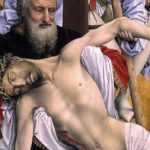
For thousands of years it has been held that spitting upon a person, especially spitting on the face of a person is severe degradation. The point was included in the Law of Moses. Recovery from such an act took seven days of privacy for the degraded person. The practice and the throwing of one’s shoe, remain as signs of dehumanizing persons in some cultures to the present day. None is taken as more the testimony of degradation as spitting in the face of a rejected human being. Chapter 9 in John’s Gospel is entirely taken up with the act of Jesus using his own spittle, accenting its qualities by mixing it with the dirt of the ground, plastering it on… Read more






